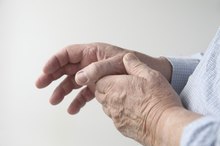Causes of a Numb Pinkie Finger
Finger numbness can significantly affect your ability to perform daily tasks. Normal sensation allows you to type without looking at your fingers, and prevents you from burning yourself or touching a sharp object. Although finger numbness is typically caused by nerve compression, it may be associated with an underlying medical condition.
If you are experiencing serious medical symptoms, seek emergency treatment immediately.
Numbness specifically in the pinkie points to involvement of particular nerves in specific locations. See your doctor to determine the cause and appropriate treatment for your pinkie finger numbness.
Nerve Root Compression
Nerves that supply sensation to your fingers begin at your cervical spine, 7 stacked bones called vertebrae in your neck. Eight pairs of spinal nerves branch off your spinal cord, exiting between your cervical vertebrae.
The eighth spinal nerve supplies sensation your outer forearm, including your pinkie finger. Pressure on this nerve may cause numbness in these areas.
Disc herniation and arthritis are the most common causes of nerve root compression in the neck. **Bones in your spine are separated by discs.
** These spongy cushions can move out of position, or herniate, putting pressure on the nerve roots as they exit your spine.
Similarly, arthritis causes breakdown of the joints between the vertebrae, decreasing the space for the nerve roots to travel through. Disc herniation or arthritis involving your seventh cervical vertebra increases pressure on the eighth spinal nerve, potentially leading to numbness in your pinkie finger.
- Nerves that supply sensation to your fingers begin at your cervical spine, 7 stacked bones called vertebrae in your neck.
- The eighth spinal nerve supplies sensation your outer forearm, including your pinkie finger.
Elbow Nerve Compression
What Are the Causes of Pain on Outer Side of Wrist?
Learn More
Spinal nerve roots branch off into many nerves that provide sensation and power muscles throughout your arm.
The ulnar nerve travels along the inside of your elbow, providing sensation to your forearm, ring and pinkie fingers. Bumping your elbow on a hard surface often aggravates the ulnar nerve, causing tingling sensations and temporary numbness in your pinkie finger -- a condition commonly called "hitting your funny bone."
Several factors contribute to long-term compression of the ulnar nerve at your elbow. This nerve travels between muscles and through a tunnel as it runs along the inner elbow.
Although the exact cause of nerve compression is not always known, these muscles and tunnel structures can compress the ulnar nerve, causing numbness in your pinkie finger. This nerve can also be damaged with elbow trauma or prolonged pressure on your elbow, which might be caused by resting it on your desk or an armrest, for example.
- Spinal nerve roots branch off into many nerves that provide sensation and power muscles throughout your arm.
- Although the exact cause of nerve compression is not always known, these muscles and tunnel structures can compress the ulnar nerve, causing numbness in your pinkie finger.
Wrist Nerve Compression
The ulnar nerve travels along your inner forearm into your hand. This nerve enters your palm on the pinkie side of your hand, travelling through a tunnel called the Guyon canal. Although rare, compression of the ulnar nerve in your hand can cause numbness in your pinkie finger 6. Tumors, cysts, blood vessel disease and arthritis can increase pressure on the ulnar nerve in the Guyon canal. In addition, the ulnar nerve can be damaged with trauma to this area of your hand. Compression of the ulnar nerve in your hand will not cause tingling in your forearm, distinguishing it from compression at your elbow or neck.
- The ulnar nerve travels along your inner forearm into your hand.
- In addition, the ulnar nerve can be damaged with trauma to this area of your hand.
Digital Nerve Injury
Causes of Elbow Pain & Tingling Fingers
Learn More
Tiny digital nerves -- 2 to 3 millimeters in diameter -- run on each side of your fingers. Damage to one of these nerves can cause numbness in your pinkie, affecting half of the finger on the side where the injury occurred. Digital nerve injuries are typically caused by lacerations or traumatic hand injuries 7. Surgery is usually required to repair the nerve and restore feeling in your finger with a digital nerve injury 7.
Other Considerations
Numbness in your pinkie finger may be caused by an underlying medical condition. For example, diabetic nerve damage is common in people who have had the disease for many years. Early on, you may have mild tingling and numbness that comes and goes, typically in your fingers or toes. Eventually the affected area may become completely numb.
Other medical conditions and certain medications and toxins can also cause finger numbness. However, numbness associated with an underlying medical condition typically occurs in several or all of the fingers rather than just the pinkie.
Pinkie finger numbness can also be caused by a stroke, a potentially life-threatening emergency. Blood clots or blood vessel damage decrease blood flow to your brain.
Sudden numbness or tingling in your fingers, particularly on one side of your body, can indicate that you are having a stroke. Seek emergency medical attention if you experience these symptoms.
Reviewed by: Tina M. St. John, M.D.
- Numbness in your pinkie finger may be caused by an underlying medical condition.
- Sudden numbness or tingling in your fingers, particularly on one side of your body, can indicate that you are having a stroke.
Related Articles
References
- Indian Journal of Plastic Surgery: Compressive Neuropathy in the Upper Limb
- The Musculoskeletal Journal of Hospital for Special Surgery: Ulnar Neuropathy at the Wrist
- The Musculoskeletal Journal of Hospital for Special Surgery: Cervical Radiculopathy -- A Review
- Practical Plastic Surgery for Nonsurgeons; Nadine B. Semer
- Journal of Hand and Microsurgery: Cubital Tunnel Syndrome -- Review of Current Literature on Causes, Diagnosis and Treatment
- Journal of Korean Neurosurgical Society: Ulnar Nerve Compression in Guyon's Canal by Ganglion Cyst
- Hand: Digital Nerve Injuries -- A Review of Predictors of Sensory Recovery After Microsurgical Digital Nerve Repair
- Physical Medicine and Rehabilitation Clinics of North America: The Spectrum of Diabetic Neuropathies
- Lee EY, Sebastin SJ, Cheah A, Kumar VP, Lim AYT. Upper Extremity Innervation Patterns and Clinical Implications for Nerve and Tendon Transfer. Plast Reconstr Surg. 2017;140(6):1209-1219. doi:10.1097/PRS.0000000000003873
- Polatsch DB, Melone CP, Beldner S, Incorvaia A. Ulnar nerve anatomy. Hand Clin. 2007;23(3):283-9, v. doi:10.1016/j.hcl.2007.05.001
- Menorca RM, Fussell TS, Elfar JC. Nerve physiology: mechanisms of injury and recovery. Hand Clin. 2013;29(3):317–330. doi:10.1016/j.hcl.2013.04.002
- Cutts S. Cubital tunnel syndrome. Postgrad Med J. 2007;83(975):28–31. doi:10.1136/pgmj.2006.047456
- Colloca L, Ludman T, Bouhassira D, et al. Neuropathic pain. Nat Rev Dis Primers. 2017;3:17002. Published 2017 Feb 16. doi:10.1038/nrdp.2017.2
- Taylor JL, Amann M, Duchateau J, Meeusen R, Rice CL. Neural Contributions to Muscle Fatigue: From the Brain to the Muscle and Back Again. Med Sci Sports Exerc. 2016;48(11):2294–2306. doi:10.1249/MSS.0000000000000923
- Dy CJ, Mackinnon SE. Ulnar neuropathy: evaluation and management. Curr Rev Musculoskelet Med. 2016;9(2):178–184. doi:10.1007/s12178-016-9327-x
- Bonaldo P, Sandri M. Cellular and molecular mechanisms of muscle atrophy. Dis Model Mech. 2013;6(1):25–39. doi:10.1242/dmm.010389
- Lleva JMC. Ulnar Neuropathy. StatPearls [Internet]. Published June 4, 2019.
- Chhabra A, Wadhwa V, Thakkar RS, Carrino JA, Dellon AL. Recurrent ulnar nerve entrapment at the elbow: Correlation of surgical findings and 3-Tesla magnetic resonance neurography. Can J Plast Surg. 2013;21(3):186–189. doi:10.1177/229255031302100305
- Assmus H, Antoniadis G, Bischoff C. Carpal and cubital tunnel and other, rarer nerve compression syndromes. Dtsch Arztebl Int. 2015;112(1-2):14–26. doi:10.3238/arztebl.2015.0014
- Depukat P, Henry BM, Popieluszko P, et al. Anatomical variability and histological structure of the ulnar nerve in the Guyon's canal. Arch Orthop Trauma Surg. 2017;137(2):277–283. doi:10.1007/s00402-016-2616-4
- Ivanov-smolensky AG. [Disordered activity of the nerves in contusion-commotion]. Voen Meditsinskii Sb. 1945;(2):193-8. PMID: 20281202
- Mankowitz SL. Laceration Management. J Emerg Med. 2017;53(3):369-382. doi:10.1016/j.jemermed.2017.05.026
- Institute of Medicine (US) Committee on Pain, Disability, and Chronic Illness Behavior. The Anatomy and Physiology of Pain. Pain and Disability: Clinical, Behavioral, and Public Policy Perspectives. Published January 1, 1987.
- Das Neves Borges P, Vincent TL, Marenzana M. Automated assessment of bone changes in cross-sectional micro-CT studies of murine experimental osteoarthritis. PLoS One. 2017;12(3):e0174294. Published 2017 Mar 23. doi:10.1371/journal.pone.0174294
- Ultrasound. National Institute of Biomedical Imaging and Bioengineering. Published 2019.
- Domkundwar S, Autkar G, Khadilkar SV, Virarkar M. Ultrasound and EMG-NCV study (electromyography and nerve conduction velocity) correlation in diagnosis of nerve pathologies. J Ultrasound. 2017;20(2):111–122. Published 2017 Jan 17. doi:10.1007/s40477-016-0232-3
- Vardeh D, Mannion RJ, Woolf CJ. Toward a Mechanism-Based Approach to Pain Diagnosis. J Pain. 2016;17(9 Suppl):T50–T69. doi:10.1016/j.jpain.2016.03.001
- Grinsell D, Keating CP. Peripheral nerve reconstruction after injury: a review of clinical and experimental therapies. Biomed Res Int. 2014;2014:698256. doi:10.1155/2014/698256
- Kamat AS, Jay SM, Benoiton LA, Correia JA, Woon K. Comparative outcomes of ulnar nerve transposition versus neurolysis in patients with entrapment neuropathy at the cubital tunnel: a 20-year analysis. Acta Neurochir (Wien). 2014;156(1):153-7. doi:10.1007/s00701-013-1962-z
- Woo A, Bakri K, Moran SL. Management of ulnar nerve injuries J Hand Surg Am. 2015 Jan;40(1):173-81. doi:10.1016/j.jhsa.2014.04.038
Writer Bio
Aubrey Bailey has been writing health-related articles since 2009. Her articles have appeared in ADVANCE for Physical Therapy & Rehab Medicine. She holds a Bachelor of Science in physical therapy and Bachelor of Arts in psychology from the University at Buffalo, as well as a post-professional Doctor of Physical Therapy from Utica College. Dr. Bailey is also a certified hand therapist.







